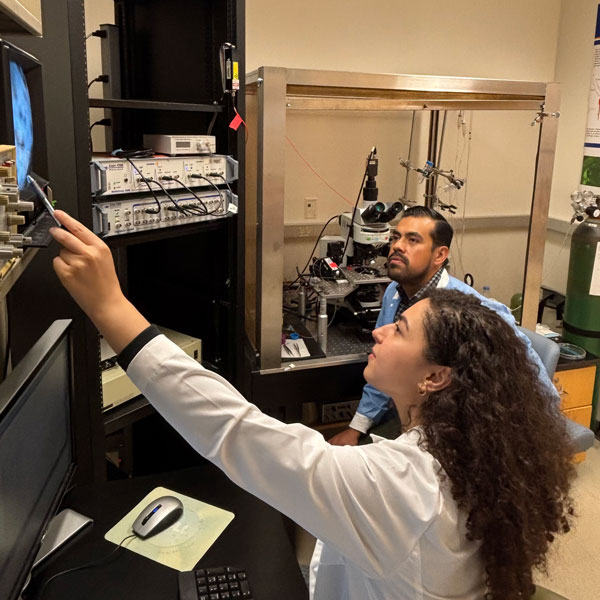New findings uncover dynamic brain mechanisms driving motivated behaviors

New research on the brain circuits regulating motivated behaviors in response to environmental signals, from the laboratories of Fabricio Do Monte, DVM, PhD, associate professor, and Michael Beierlein, PhD, professor, in the Department of Neurobiology and Anatomy, has been published in the journal Neuron.
The first author of the paper titled, “Functional properties of corticothalamic circuits targeting paraventricular thalamic neurons” is Guillermo Aquino-Miranda, PhD, postdoctoral fellow, and Dounya Jalloul, graduate student at The University of Texas MD Anderson Cancer Center UTHealth Houston Graduate School of Biomedical Sciences is the second author.
Animals, including humans, constantly use environmental cues to guide their behaviors. When cues signal potential rewards – such as the sight or smell of food – animals engage in exploratory behaviors that increase their chances of obtaining a food reward. Conversely, when cues suggest danger, animals shift to defensive modes that help them to avoid potential harm. This dynamic adjustment in behavior allows animals to maximize their survival and well-being by responding flexibly to surrounding cues related to either positive or negative consequences.
The paraventricular nucleus of the thalamus (PVT) is a key brain region in the regulation of reward- and threat-related behaviors, but it remains unclear how neurons in the PVT promote or suppress these motivated behaviors in response to environmental cues. To elucidate this question, Aquino-Miranda and colleagues investigated how the activity of PVT neurons is regulated by connections from the prelimbic (PL) prefrontal cortex, a region that plays a critical role in evaluating environmental cues and facilitating decision-making processes.
They examined both the direct connection between PL cortex and PVT, which is excitatory, and the indirect connection that goes through another brain area called the thalamic reticular nucleus (TRN), which is inhibitory. The group wanted to test the hypothesis that these connections may enable rapid and flexible adjustment of motivated behaviors in response to changes in environmental cues.
Their research found that the same PVT neurons receive information from both the PL cortex and the TRN.
“Surprisingly, we found that all neurons in the PVT receive both direct excitatory and indirect inhibitory inputs from PL cortex,” Jalloul said. “These inputs are integrated on a moment-to-moment basis to control the neuronal outputs of PVT neurons to different brain targets, therefore resulting in distinct motivated behaviors.”
Using in vivo and in vitro electrophysiological recordings alongside optogenetic tools to respectively monitor and manipulate neuronal activity, the authors found that PL cortex directly excites a subset of PVT neurons, enabling them to respond rapidly. However, during intense and prolonged PL cortex activity, a second population of PVT cells enter a silent state called depolarization block, in which they temporarily stop their activity.
“Previous textbook knowledge suggests that increased excitatory activity leads to increased neuronal activity in targeted neurons. However, our paradoxical findings demonstrated that excitation from the PL cortex can lead to direct inhibition by causing about half of the PVT neurons to get silenced and enter a state of depolarization block,” Aquino-Miranda said.
In their experiments, the researchers discovered that the indirect PL cortex pathway via the TRN sends inhibitory signals to the PVT to counterbalance the depolarization block effect. Surprisingly, this inhibition restores neuronal activity and prevents the depolarization block state, thereby enabling PVT neurons to respond effectively to high-frequency signals. This finding is unexpected because, rather than suppressing activity, the inhibition here helps maintain neuronal activity in PVT.
To further investigate how PL cortex activity regulates PVT activity in freely behaving animals, the researchers trained preclinical rodent models to respond to an auditory cue by pressing a lever to receive sucrose pellets or by moving to the opposite side of the chamber to avoid a mild stressor. They found that activating the PL cortex pathway to the PVT during cues that predict either food availability or stress impaired food-seeking or avoidance responses. However, when the same pathway was activated at higher frequencies during the cues, the models shifted their behavior and resumed responding to the auditory cues.
Beierlein suggests that this study may enhance the understanding of the neural mechanisms by which top-down cortical information regulates thalamic activity. Do Monte said he believes that these findings could help provide insights into how the brain selects adaptive behaviors in response to environmental cues, thereby helping to better understand motivated behaviors in humans.
The work was supported by grants R01-MH120136 and R01-MH131570 from the National Institutes of Health.